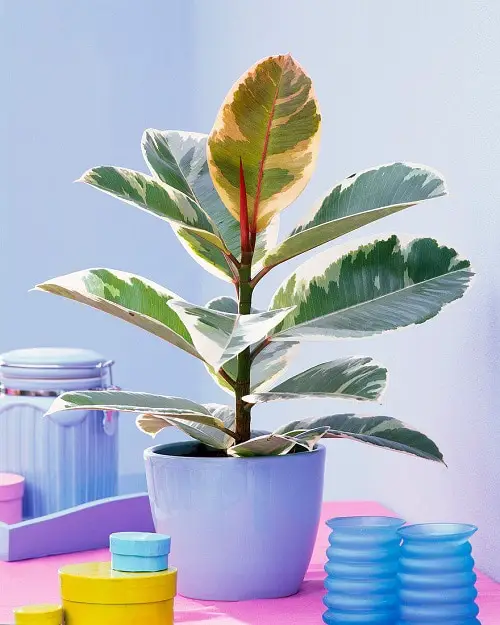
Tineke Rubber Plant is a variegated rubber tree variety that displays dark and light green patchy leaves with off-white edges and pink stems. Let’s have a look at the Ficus Tineke Rubber Tree Care to keep it thriving all year round.
Here are the best types of rubber plants you can grow
Propagating Ficus Tineke Rubber Tree

You can propagate it easily by taking a small branch from a healthy Ficus Tineke Rubber Tree and allowing it to root in water or soil. Allow the sap from the stem to dry first before planting.
One more simple way of growing is by air layering. For doing this, cut a healthy plant and attach a toothpick to the opening. Pack it in damp moss and cover it in a plastic sheet. When you notice roots growing in the moss, cut the branch off and grow it in fresh soil.
Ficus Tineke Rubber Tree Growing Requirements
Location
Ficus Tineke does best in filtered sunlight coming from a transparent curtain near the window, and it doesn’t mind bright, indirect light either.
One of the most significant takeaways is–it can lose its tremendous variegation on new growth if it does not get sufficient light. Exposing the plant to a couple of hours of morning sunlight is always rewarding.
Soil
The plant does well in a wide range of soils and performs best in a good-quality, well-drained potting mix suitable for houseplants.
Water
If you’re growing it in a semi-outdoor condition like a porch, you should do regular watering. Indoors, it is best to wait until the soil seems dry before watering again. Keeping it on a drier side can save you from overwatering this beautiful ficus elastica species.
A Tip: Use a damp cotton cloth and wipe the foliage once in 7-10 days to keep the leaves clean and shiny.
Temperature
Ficus Tineke does best in the temperature range of 60-80 F (15-27 C). It can tolerate winter temperatures down to 40 F (4 C) and summer temperatures up to 100 F (38 C).
Humidity
Being a rubber tree variety, it’s inclined towards a tropical environment–Moderately cool and humid surrounding makes it happiest. To maintain humidity in dry air months, you can use a humidifier.
Ficus Tineke Rubber Tree Care

Fertilizer
Feed the Tineke Rubber Plant once in 4-6 weeks in spring and summer with an all-purpose liquid fertilizer diluted to half of the recommended strength. Also, spraying fertilizer on foliage does wonders. Additionally, you can also apply Epsom salt once in a while!
Pests and Diseases
Ficus Elastica Tineke is resistant to many common pests and diseases, but it invites visitors like mealybugs and spider mites if grown in poor conditions and low light.
Re-potting
Repotting can be done every few years or every year according to how fast the plant is growing and the size of the planter. Do not re-pot the Tineke rubber plant frequently if you like to keep it in its current size.
Pruning
Pruning is necessary if you want to keep the rubber plant in the desired shape or size and remove unwanted branches.
Note: Make sure to wash your hands after pruning as its sap can irritate the skin–you can wear hand gloves as well.
Best Location to Keep it

Thanks to its striking looks, good height, and air purifying abilities, the plant looks great anywhere indoors, going well with the modern decor as well as appearing perfect in a mid-century interior setting.
Toxicity
The leaves of Ficus Tineke are mildly toxic to humans and pets. Generally, if ingested, it can cause non-serious medical issues like diarrhea or vomiting, depending on the quantity consumed. Keep it away from the reach of toddlers and playful puppies and cats.


